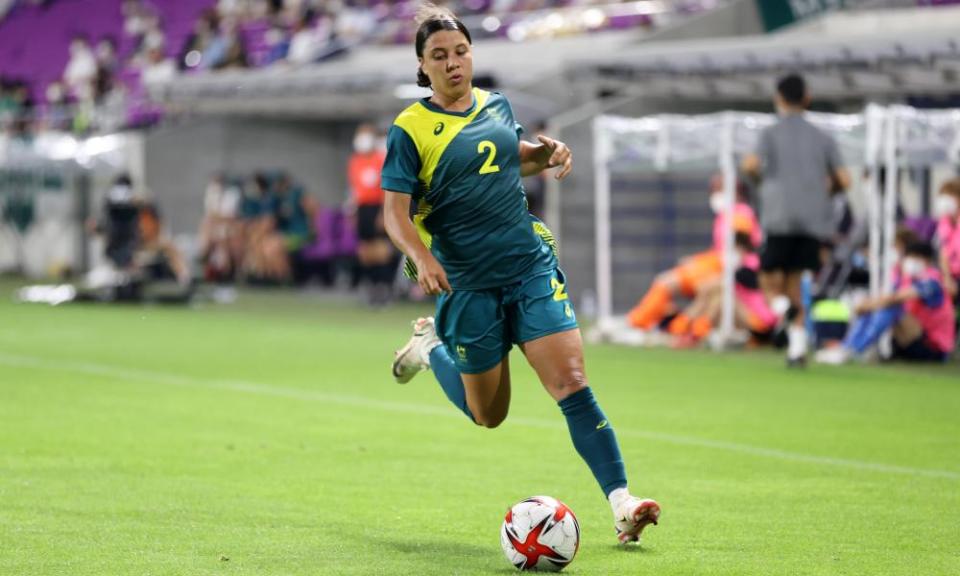Matildas’ latest defeat shines light on gap between expectations and reality

If Matildas head coach Tony Gustavsson’s project for the past six months has been to get his players to “see the same picture”, it is a picture that many are still squinting and tilting their heads to make out. With just a week to go until the Olympics in Tokyo, where Australia are considered in some circles to be capable of a podium finish, the looming question is how exactly Gustavsson’s team will get there.
An answer was expected to be offered on Wednesday night when the Matildas faced Games hosts Japan in their final friendly before the start of the tournament next week. Indeed, as Gustavsson himself mentioned before the game, they aimed to play it “scoreboard-blind”: the purpose of the Japan match was to experiment with the tactics they would use in their first group-stage game against New Zealand on 21 July. This was meant to provide insight into what can be expected come that day.
Related: Japan beat Matildas 1-0 in final tune-up for Tokyo Olympics
However, what the team presented at Sanga Stadium was not a solid, 90-minute performance set against a single philosophical backdrop. Instead, it felt more like a farrago of combinations and chemistries, each of which had appeared in patches across Australia’s past four friendlies and which, once again, left observers wondering what the plan actually looks like.
There was perhaps no clearer a metaphor for the game itself than the hastily-organised broadcast stream which, for the opening half-hour, was commentated entirely in Japanese after a mix-up with Australian audio, while the video itself stuttered and buffered and sometimes skipped several seconds altogether.
On the pitch, Gustavsson chopped and changed players and positions over the course of both halves, including six substitutions at half-time. Once again, some players were used in unusual positions – Tameka Yallop at left midfield, Ellie Carpenter at right centre-back, Emily Van Egmond as a defensive midfielder – that felt, at times, more prohibitive than productive.
Tightly-matched though the game itself may have been, the reality now is that Australia remain winless in five heading into a tournament where they will face teams of the same calibre, and higher, that they were recently re-acquainted with.
It seems time, then, to talk about what is expected from this Matildas side. Coincidentally, Japan provides an interesting case study to compare with Australia’s own trajectory over the past few years.
The Matildas arrived on the international scene in the wake of Japan’s own “golden generation” beginning its decline. Following their 2011 Women’s World Cup win, as well as making the final of the 2015 tournament, Japan failed to qualify for the Rio Olympics the next year. That was Japan’s transition moment – a turn-over of players and head coach as part of a longer-term program to return the nation to the summit of the women’s game.
As Japan slowly slipped down the mountain, Australia began to climb it. Their best-ever World Cup and Olympic finishes came in those same tournaments, building towards arguably their greatest year to date: 2017. That is when the Matildas emerged from beneath their “plucky underdog” status, defeating the USA for the first time and serially demolishing the likes of Brazil and Japan.
Crucially, this was also a time when the women’s game was becoming more visible, accessible and popular. Tournaments like the one in which Australia defeated the USA were well-attended and widely watched; its long-hidden stories making their way to mainstream headlines. It was the arrival of Sam Kerr – that famous backflip following her hat-trick against Japan – as well as the joyful, spirited character of the Matildas that fans have since come to know and love.
Related: Matildas’ Olympic squad tailor-made for unpredictable Tokyo Games | Samantha Lewis
It was within this context that Australia’s expectations around the Matildas begin to be formed. It was against this context that their performance at the 2019 Women’s World Cup was assessed. And it is through this context that they continue to be measured, even though the global landscape has shifted so vastly that it is almost unrecognisable from that sparkling year.
Japan recognised that they were approaching the natural trough to their peak years and planned accordingly. The Matildas, on the other hand, perhaps didn’t realise they had stumbled upon their peak period early. Now, they are trying to prolong it; trying keep their heads above the tide that is rapidly rising around them.
So while the image that Gustavsson is painting with his players may still be unclear, it is important to keep this bigger picture in mind when considering expectations, both in Tokyo and moving forward. It may not be the dazzling portrait that has been hoisted in the halls of Australian sporting greatness – but it is a picture we may all have to get used to.

 Yahoo Sport
Yahoo Sport 





































